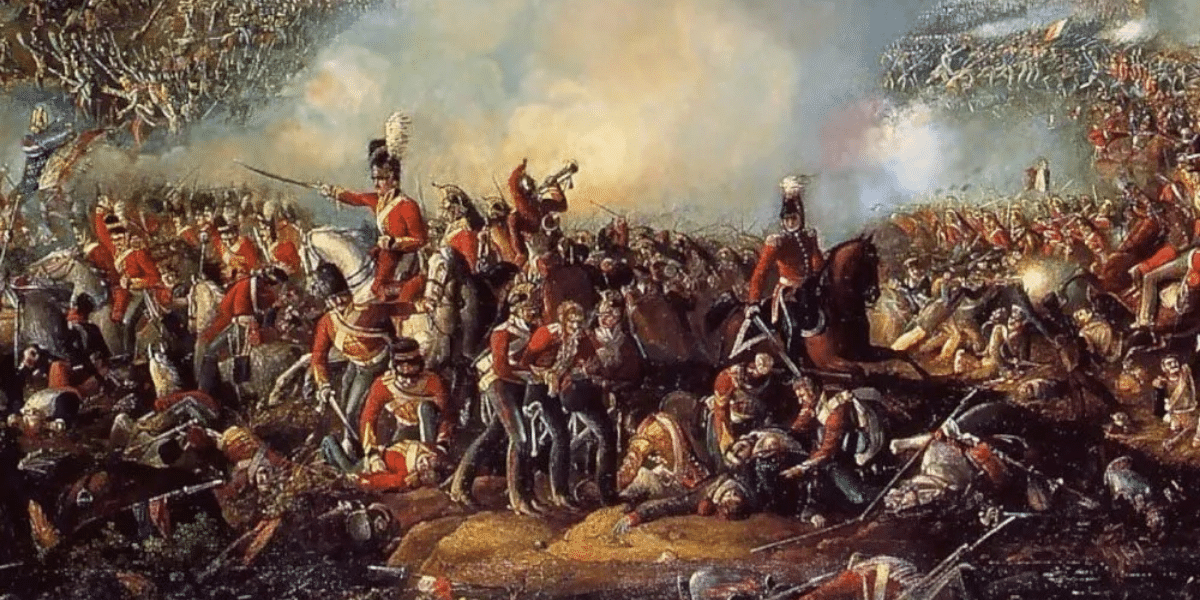
Quick Summary
Table of Contents
The Battle of Buxar, fought on 22 October 1764, marked a defining moment in the expansion of British rule in India. It was a decisive confrontation between the British East India Company and a coalition of Indian powers led by Mir Qasim (Nawab of Bengal), Shuja-ud-Daula (Nawab of Awadh), and Shah Alam II (Mughal Emperor). Taking place in Buxar, Bihar, the British victory in this battle not only reinforced their military supremacy but also paved the way for the Treaty of Allahabad (1765), which granted them Diwani rights (revenue collection) in Bengal, Bihar, and Orissa. This blog explores its causes, major players, outcomes, and lasting impact on India’s colonial history.
The Battle of Buxar was fought on 22 October 1764, between the English forces and a combined army of the Nawab of Oudh, the Nawab of Bengal, and the Mughal Emperor. The conflict arose due to the East India Company’s exploitation of trade privileges granted by the Nawab of Bengal, along with its growing colonial ambitions.
| Battle of Buxar | Details |
|---|---|
| Date | October 22, 1764 |
| Location | Buxar, Bihar, India |
| Opposing Forces | British East India Company vs. Nawab of Bengal, Nawab of Awadh, Mughal Emperor |
| British Commander | Hector Munro |
| Allied Commanders | Mir Qasim (Nawab of Bengal), Shuja-ud-Daula (Nawab of Awadh), Shah Alam II (Mughal Emperor) |
| Outcome | Victory for the British East India Company |
| Consequences | Solidified British control over Bengal paved the way for British dominance in India. |

During the mid-18th century, India was going through a turbulent time marked by the fall of the Mughal Empire and the rise of regional rulers. At the same time, the British East India Company was gaining ground—not just through trade but also through increasing military involvement. Although Mir Qasim, the Nawab of Bengal, initially supported the British, he turned against them due to unfair trade practices and later allied with Shuja-ud-Daula and the Mughal Emperor Shah Alam II. The British, having already taken control of Bengal after the Battle of Plassey in 1757, were looking to expand further, which led to the conflict at Buxar. Many believe it was this battle—not Plassey—that solidified British dominance in India.
Secrets of the Battle of Buxar:
Each participating party in the Battle of Buxar had its inspirations. The English East India Company, driven by Major Hector Munro, planned to tighten its grip on Bengal and gain income privileges over different domains. On the opposite side, Mir Qasim needed to recover Bengal, Shuja-ud-Daula meant to safeguard Oudh, and Shah Alam II looked to reestablish the respect of the Mughal Empire.
| Participants | Respective Roles |
| Mir Qasim | The English terms “Dastak” and “Farmans” offended him. He plotted against the Mughal Emperor Shah Alam II and the Nawab of Awadh by forming an alliance. |
| Shuja-ud-Daulah | He was Awadh’s Nawab. Along with Mir Qasim and Shah Alam II, he established a confederacy. |
| Shah Alam II | The Mughal Emperor was he. His goal was to expel the English from Bengal. |
| Hector Munro | He was a British Army major. He led the English side in the Buxar War. |
| Robert Clive | After winning the Buxar War, he made treaties with Shah Alam II and Shuja-Ud-Daulah. |

The Battle of Buxar was a clash between two opposing forces: the British East India Company and a coalition of Indian rulers. This coalition consisted of Mir Qasim, the Nawab of Bengal; Shuja-ud-Daula, the Nawab of Oudh; and Shah Alam II, the Mughal Emperor.
On the British side, the key leader was Major Hector Munro, a great military commander. He was in charge of the British East India Company’s forces and was known for his tactical brilliance. For the Indian coalition, Mir Qasim Shuja-ud-Daula and Shah Alam II were the principal leaders.
The English had a thoroughly prepared armed force, having unrivalled big guns and restrained troops. Their technique was to utilize their cannons effectively and keep a tight formation to counter the mush but less coordinated Indian powers. The Indian alliance, then again, had a bigger armed force; however, it came up short on discipline and high-level weapons that the English had. Their system was to overpower the English with numbers and utilize their insight into the neighbourhood landscape for their potential benefit.
The battle took place on October 22, 1764. The war’s geographical location is in present-day Bihar, India. The battle of Buxar’s date and its location are significant because the area provided a strategic advantage to the British, allowing them to utilize their artillery effectively.
The Battle of Buxar was a complex military engagement with multiple participants, each with their leader’s strengths and strategies. The British East India Company emerged victorious largely due to their superior military tactics and discipline, forever altering the course of Indian history.
The Battle of Buxar was a day-long conflict that unfolded with intense ferocity. Both sides had their strategies and objectives, but as the day progressed, it became clear that the British had the upper hand.
Read More:-
This timeline highlights the rising tensions, the formation of resistance against the British, and their ultimate victory at Buxar. The treaty that followed cemented their dominance in the region.
The winner of this battle was the British East India Company. Their disciplined troops and strategy led to a win for them and altered the course of Indian history.
The result of the Battle had a great impact on the political landscape of India. The British East India Company gained immense power. They secured the Diwani rights, which allowed them to collect revenue from Bengal, Bihar, and Orissa. This financial gain enabled them to strengthen their military and administrative capabilities, setting the stage for further territorial expansion.
The Indian rulers involved in the battle suffered big losses. They dethroned and exiled Mir Qasim. Shuja-ud-Daula lost control over parts of his territory, and the Mughal Emperor Shah Alam II became a puppet ruler under British protection. The defeat weakened the political dominance of these rulers and made it clear that the British were the new dominant force in the region.
The territorial implications of the victory were vast. The British now controlled rich regions, which they used to fund their colonial endeavours. The Treaty of Allahabad, signed in 1765, rectified these territorial gains and revenue rights. This treaty gave the British control over large parts of India and legitimized their rule, making it easier for them to expand further.
The outcome and result of the Battle were pivotal. The British ultimately prevailed, obtaining enormous financial and geographical benefits. After the Indian coalition was defeated, the balance of power changed, making the British control India and dominating the force for many years.
The Treaty of Allahabad, a major agreement, was signed on August 16, 1765, following the Battle of Buxar in 1764. The following are the treaty’s principal points:
| Aspect | Battle of Plassey | Battle of Buxar |
|---|---|---|
| Date | June 23, 1757 | October 22, 1764 |
| Location | Plassey, Bengal, India | Buxar, Bihar, India |
| Opposing Forces | British East India Company vs. Nawab of Bengal | British East India Company vs. Nawab of Bengal, Nawab of Awadh, Mughal Emperor |
| British Commander | Robert Clive | Hector Munro |
| Local Commanders | Siraj-ud-Daulah (Nawab of Bengal) | Mir Qasim (Nawab of Bengal), Shuja-ud-Daula (Nawab of Awadh), Shah Alam II (Mughal Emperor) |
| Outcome | Victory for the British East India Company | Victory for the British East India Company |
| Consequences | Start of British political control in Bengal | Solidified British control over Bengal, expanded British influence in India |
The Battle of Buxar was a pivotal event in Indian history that marked the rise of British power in India. Its outcome led to significant political shifts and territorial gains for the British East India Company, while weakening the influence of Indian rulers. More than just a military victory, the battle shaped the future of colonial rule, making it one of the most important conflicts in India’s past.
The British East India Company won the Battle of Buxar on October 22, 1764, defeating the combined forces of Mir Qasim, Shuja-ud-Daula, and Mughal Emperor Shah Alam II.
The battle demonstrated the British forces’ military superiority and weakened the indigenous rulers’ power. It paved the way for the British to establish a stronghold in India, eventually leading to colonial rule.
Mir Qasim, the Nawab of Bengal, was defeated in the Battle of Buxar in 1764. After the battle, Mir Jafar became Nawab and ceded Midnapore, Burdwan, and Chittagong to the British East India Company to support their army.
India lost the Battle of Buxar due to a lack of unity among the Indian rulers and poor coordination between their forces. In contrast, the British East India Company had superior tactics, better-trained soldiers, and artillery support.
The Battle of Buxar was fought on October 22, 1764, in today’s Bihar.
Signed in 1765, the treaty granted the British East India Company the Diwani rights (revenue collection) over Bengal, Bihar, and Odisha, cementing their rule.
Hector Munro led the British forces to victory, showcasing superior military tactics against the combined Indian forces.
The Battle of Buxar was fought between the British East India Company and a combined Indian alliance consisting of Mir Qasim (Nawab of Bengal), Shuja-ud-Daula (Nawab of Awadh), and Shah Alam II (Mughal Emperor). It took place on 22 October 1764 near Buxar in Bihar and ended in a decisive British victory.
The Battle of Plassey (1757) was a political betrayal involving the British and Mir Jafar, which established initial British control in Bengal. The Battle of Buxar (1764), however, was a full-scale military conflict. Its victory gave the British East India Company administrative rights and confirmed their political dominance across major North Indian provinces.

Authored by, Muskan Gupta
Content Curator
Muskan believes learning should feel like an adventure, not a chore. With years of experience in content creation and strategy, she specializes in educational topics, online earning opportunities, and general knowledge. She enjoys sharing her insights through blogs and articles that inform and inspire her readers. When she’s not writing, you’ll likely find her hopping between bookstores and bakeries, always in search of her next favorite read or treat.
Editor's Recommendations
Chegg India does not ask for money to offer any opportunity with the company. We request you to be vigilant before sharing your personal and financial information with any third party. Beware of fraudulent activities claiming affiliation with our company and promising monetary rewards or benefits. Chegg India shall not be responsible for any losses resulting from such activities.
Chegg India does not ask for money to offer any opportunity with the company. We request you to be vigilant before sharing your personal and financial information with any third party. Beware of fraudulent activities claiming affiliation with our company and promising monetary rewards or benefits. Chegg India shall not be responsible for any losses resulting from such activities.